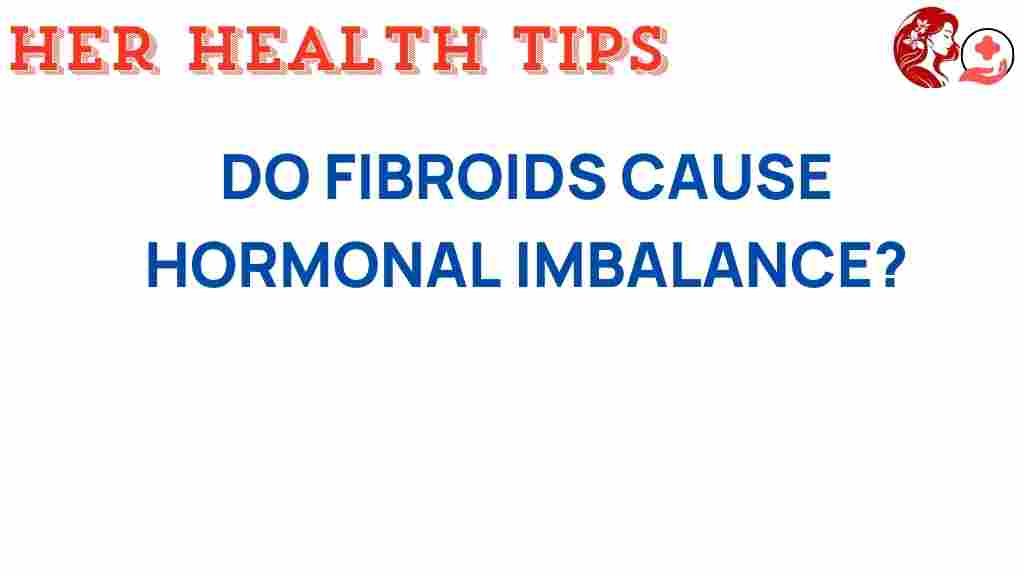Unraveling the Link Between Fibroids and Hormonal Imbalance
Fibroids are non-cancerous growths that develop in or on the uterus, often linked to hormonal imbalances, particularly fluctuations in estrogen levels. Understanding the connection between fibroids and hormonal imbalance is crucial for women’s health, as these conditions can significantly affect reproductive health and overall well-being. This article explores the symptoms, diagnosis, treatment options, and lifestyle adjustments that can aid in managing fibroids and hormonal imbalance.
What Are Fibroids?
Fibroids, also known as uterine leiomyomas or myomas, are muscular tumors that can grow in various sizes, from tiny seedlings to large masses that can distort the shape of the uterus. They are quite common, especially in women of reproductive age. Here are some key points about fibroids:
- They are usually benign (non-cancerous).
- Fibroids can be located within the uterine wall, on its surface, or inside the uterine cavity.
- They may vary in size and number, with some women having multiple fibroids.
Understanding Hormonal Imbalance
Hormonal imbalance refers to the situation when there is too much or too little of a particular hormone in the bloodstream. In women, hormones such as estrogen and progesterone play pivotal roles in regulating the menstrual cycle, reproductive health, and overall wellness. An imbalance in these hormones can lead to various health issues, including:
- Irregular menstrual cycles
- Weight gain
- Fatigue
- Depression or anxiety
How Fibroids and Hormonal Imbalance Are Linked
The relationship between fibroids and hormonal imbalance is primarily influenced by estrogen. Fibroids are sensitive to estrogen levels; they tend to grow when estrogen levels are elevated. Here are some insights into this connection:
- Estrogen Dominance: This condition occurs when there is an excess of estrogen in comparison to progesterone. It can promote the growth of fibroids.
- Menstrual Cycle Fluctuations: Abnormalities in the menstrual cycle can lead to fluctuations in hormone levels, further exacerbating the growth of fibroids.
- Menopause: Fibroids often shrink after menopause due to a decrease in estrogen production.
Symptoms of Fibroids
Identifying the symptoms of fibroids is essential for prompt diagnosis and treatment. Common symptoms include:
- Heavy or prolonged menstrual bleeding
- Pelvic pain or pressure
- Frequent urination
- Difficulty emptying the bladder
- Constipation
- Back or leg pain
Some women may experience no symptoms at all, making regular check-ups crucial for early detection.
Diagnosis of Fibroids
Diagnosing fibroids typically involves a combination of medical history reviews, physical examinations, and imaging tests. The following methods are commonly used:
- Pelvic Exam: A doctor may perform a pelvic exam to feel for abnormalities in the uterus.
- Ultrasound: This imaging technique uses sound waves to create images of the uterus and identify fibroids.
- Magnetic Resonance Imaging (MRI): MRI provides detailed images and helps determine the size and location of fibroids.
Treatment Options for Fibroids
Treatment for fibroids depends on their size, location, symptoms, and whether you wish to maintain fertility. Here are some common treatment options:
- Medications: Hormonal therapies, such as birth control pills, can help manage symptoms by regulating hormone levels.
- Non-invasive Procedures: MRI-guided focused ultrasound surgery is a non-invasive technique that destroys fibroids.
- Minimally Invasive Procedures: Uterine artery embolization (UAE) cuts off the blood supply to fibroids, causing them to shrink.
- Surgery: In severe cases, a myomectomy (removal of fibroids) or hysterectomy (removal of the uterus) may be required.
Lifestyle Changes to Manage Fibroids and Hormonal Imbalance
Making certain lifestyle changes can help manage fibroids and hormonal imbalance effectively:
- Diet: A balanced diet rich in fruits, vegetables, whole grains, and lean proteins can help regulate hormones. Limit processed foods, sugar, and saturated fats.
- Exercise: Regular physical activity can help maintain a healthy weight and reduce estrogen levels.
- Stress Management: Stress can exacerbate hormonal imbalances. Practices such as yoga, meditation, and deep-breathing exercises can be beneficial.
- Regular Check-ups: Regular visits to a healthcare provider can help monitor reproductive health and manage any emerging issues related to fibroids.
Holistic Approaches to Women’s Health
In addition to conventional treatments, some women explore holistic approaches to enhance overall health and manage fibroids. These may include:
- Herbal Remedies: Some herbs, like chasteberry and green tea, may help balance hormones.
- Acupuncture: This traditional Chinese medicine practice may help alleviate symptoms and promote hormonal balance.
- Nutrition Supplements: Supplements such as omega-3 fatty acids and vitamin D may support hormonal balance.
It’s important to consult a healthcare professional before starting any new treatment or lifestyle change.
Troubleshooting Tips for Managing Symptoms
If you experience symptoms associated with fibroids or hormonal imbalance, consider the following troubleshooting tips:
- Keep a symptom diary to track changes related to your menstrual cycle and lifestyle.
- Seek guidance from a healthcare provider to tailor a treatment plan to your specific needs.
- Consider joining a support group for women with similar experiences to share knowledge and strategies.
- Stay informed about your reproductive health by reading reputable sources and research articles.
- Incorporate relaxation techniques into your daily routine to help manage stress.
Conclusion
The link between fibroids and hormonal imbalance is a critical aspect of women’s health that warrants attention and understanding. By recognizing the symptoms, seeking timely diagnosis, and exploring treatment options, women can take proactive steps towards managing fibroids and maintaining hormonal balance. Lifestyle changes play a significant role in this journey, empowering women to enhance their reproductive health and overall well-being.
For more information on women’s health and reproductive issues, visit this resource that provides valuable insights and support.
Remember, it’s essential to consult with healthcare professionals to create a personalized plan that fits your health needs. Stay informed, stay healthy, and prioritize your well-being!
This article is in the category Reproductive and created by HerHealthTips Team
